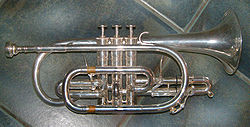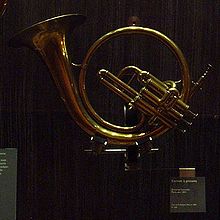- Cornet
-
This article is about the B♭ instrument. For E♭ instrument, see Soprano cornet. For other meanings of the word Cornet, see Cornet (disambiguation).
Cornet 
A B♭ cornetBrass instrument Classification Hornbostel–Sachs classification 423.232
(Valved aerophone sounded by lip movement)Developed Early 19th century from the post horn Playing range Written range: Related instruments Musical instruments Woodwinds Brass instruments Percussion String instruments Keyboards The cornet is a brass instrument very similar to the trumpet, distinguished by its conical bore, compact shape, and mellower tone quality. The most common cornet is a transposing instrument in B♭. It is not related to the renaissance and early baroque cornett or cornetto.
Contents
History
The cornet was originally derived from the post horn around 1820 in France. Among the first manufacturers of modern cornets were Parisian Jean Asté in 1828.[dubious ] Cornets first appear as separate instrumental parts in 19th century French compositions.[1]
This instrument could not have been developed without the improvement of piston valves by Heinrich Stölzel and Friedrich Blühmel. In the early 19th century, these two instrument makers almost simultaneously invented the modern valves, as still used today. They jointly applied for a patent and were granted this for a period of ten years. The first notable virtuoso player was Jean-Baptiste Arban, who studied the cornet extensively and published La grande méthode complète de cornet à piston et de saxhorn, commonly referred to as the Arban method, in 1864.[2] Up until the early 20th century, the trumpet and cornet coexisted in musical ensembles. In symphonic repertoire one will often find separate parts for both trumpet and cornet. As several instrument builders made improvements to both instruments, they started to look and sound more alike. The modern day cornet is used in brass bands, concert bands, and in specific symphonic repertoire that requires a more mellow sound.[3]
The name cornet is derived from corne, meaning horn, itself from Latin cornus. While not musically related, instruments of the Zink family (which includes serpents) are named "cornetto- " with a tonal or pitch related Latin word following the hyphen to describe the particular variant. The 11th edition of the Encyclopædia Britannica referred to serpents as "old wooden cornets".[4] The Roman/Etruscan cornu (or simply "horn") is the lingual ancestor of these. It is a predecessor of the post horn from which the cornet evolved and was used like a bugle to signal orders on the battlefield.[3]
The instrument was once sometimes referred to as a cornopean, referencing the earliest cornets with the Stölzel valve system.[citation needed]
Relationship to trumpet
The cornet was invented by adding valves to the post horn in 1814. The valves allowed for melodic playing throughout the register of the cornet. Trumpets were slower to adopt the new valve technology, so for the next 100 years or more, composers often wrote separate parts for trumpet and cornet. The trumpet would play fanfare-like passages, while the cornet played more melodic passages. The modern trumpet has valves that allow it to play the same notes and fingerings as the cornet.[5]
Cornets and trumpets made in a given key (usually the key of B♭) play at the same pitch, and the technique for playing the instruments is nearly identical. However, cornets and trumpets are not entirely interchangeable, as they differ in timbre. Also available, but usually seen only in the brass band, is an E♭ soprano model, pitched a fourth above the standard B♭. There is usually only one E♭ cornet in a band, adding an extreme high register to the brass band sound. It can be effective in cutting through even the loudest tutti climax.[6]
Unlike the trumpet, which has a cylindrical bore up until the bell section, the tubing of the cornet has a mostly conical bore, starting very narrow at the mouthpiece and gradually widening towards the bell. Cornets following the 1913 patent of E.A. Couturier can have a continuously conical bore. The conical bore of the cornet is primarily responsible for its characteristic warm, mellow tone, which can be distinguished from the more penetrating sound of the trumpet. The conical bore of the cornet also makes it more agile than the trumpet when playing fast passages, but correct pitching is often less assured.[3] The cornet is often preferred for young beginners as it is easier to hold, with its centre of gravity much closer to the player.
The cornet mouthpiece has a shorter and narrower shank than a trumpet mouthpiece, in order to fit the cornet's smaller mouthpiece receiver. The cup size is often deeper than that of a trumpet mouthpiece.[4]
The cornet in the Webster's Dictionary illustration is a short model traditional cornet, also known as a "Shepherd's crook" shaped model. These are most often large–bore instruments with a rich mellow sound. There is also a long-model cornet, usually with a smaller bore and a brighter sound, which is closer to a trumpet in appearance. The Shepherd's Crook model is preferred by cornet traditionalists. The long-model cornet is generally used in concert bands in the United States, but has found little following in British-style brass and concert bands.[7][8]
Playing technique
Like the trumpet and all other modern brass wind instruments, the cornet makes a sound when the player vibrates ("buzzes") the lips in the mouthpiece, creating a vibrating column of air in the tubing. The frequency of the air column's vibration can be modified by changing the lip aperture or "embouchure". In addition, the column of air can be lengthened by engaging one or more valves, thus lowering the pitch.
Without valves, the player could only produce a harmonic series of notes like those played by the bugle and other "natural" brass instruments. These notes are far apart for most of the instrument's range, making diatonic and chromatic playing impossible except in the extreme high register. The valves change the length of the vibrating column and provide the cornet with the ability to play chromatically.[4]
Ensembles with cornets
Brass band (British style)
British style brass band ensembles consist completely of brass instruments (except for the percussion section). The cornet is the leading melodic instrument in this ensemble and trumpets are never used. The ensemble consists of about thirty musicians, including nine B♭ cornets and one E♭ cornet (soprano cornet) in the higher registers. In England, companies such as Besson and Boosey and Hawkes specialized in these instruments. In America, 19th century manufacturers such as Graves and Company, Hall and Quinby, E.G. Wright and the Boston Musical Instrument Manufactury built lines of instruments for this format of ensemble.
Concert band
The cornet also features in the British-style concert band, unlike the American concert band or wind band, where it is replaced by the trumpet. This slight difference in instrumentation derives from the British concert band's heritage in military bands, where the highest brass instrument is always the cornet. There are usually four to six B♭ cornets present in a concert band, but no E♭ instrument, as this role is taken by the E♭ clarinet.
Fanfare orkest
Fanfare orkesten ("fanfare orchestras"), only found in the Netherlands, Belgium, Northern France and Lithuania use the complete saxhorn family of instruments. The standard instrumentation includes both the cornet and the trumpet; however, in recent decades, the cornet has largely been replaced by the trumpet.
Jazz ensemble
In old style jazz bands, the cornet was preferred to the trumpet, but from the swing era onwards it has been largely replaced by the trumpet, although it has never passed completely out of use. The cornet is now rarely found in big bands mainly because of its limited volume and less piercing tone in comparison to the trumpet. A growing taste for louder and more aggressive sounding instruments has been the chief cause of this trend, especially since the advent of bebop in the post World War II era.
The legendary jazz pioneer Buddy Bolden played the cornet, and Louis Armstrong started off on the cornet but later switched to the trumpet. Cornetists such as Bubber Miley and Rex Stewart contributed substantially to the Duke Ellington Orchestra's early sound. Other influential jazz cornetists include King Oliver, Bix Beiderbecke, Ruby Braff and Nat Adderley. Notable performances on cornet by players generally associated with the trumpet include Freddie Hubbard's on Empyrean Isles by Herbie Hancock and Don Cherry's on The Shape of Jazz to Come by Ornette Coleman.
Lists of important players
Today's players
These are some influential cornet players in the world today.
- Bobby Bradford, solo jazz recording artist and musical associate of saxophonist Ornette Coleman and clarinetist John Carter.
- Marc Charig, British cornetist and trumpeter, played with Centipede and King Crimson.
- Philip Cobb, solo cornetist of the Hendon Band of the Salvation Army, and Joint Principal Trumpet of the London Symphony Orchestra.
- Jim Cullum, Jr., jazz musician and preservationist of Dixieland.
- Olu Dara, jazz musician and father of noted rapper Nas.
- Dave Douglas, New York based jazz musician and composer, with a long association with John Zorn's Masada.
- Digby Fairweather, leader of Digby's Half Dozen, frequent accompanists to Paul Jones and George Melly.
- Clifton Hyde, musician in the Blue Man Group.
- Dr. Neil "Nelly" Kelly, cornet player for British punk/ska band King Prawn.
- Richard Marshall, principal cornet of the Black Dyke Band.
- Leon Oakley, San Francisco cornetist with the Turk Murphy band (1968–1979) and South Frisco Jazz Band
- Mark Roberts, Parramatta-based traditional style player and former Parramatta Salvation Army YP Bandmaster.
- Robert Schulz - a cornetist who played with the legendary Turk Murphy before leading his own Frisco Jazz band.
- James Shepherd was the bridge between the great players of the post-war period and modern superstars. He replaced Maurice Murphy as principal cornet of the Black Dyke Band.
- Bill Taft, American cornetist, lead singer and guitarist, played with Benjamin Smoke in Atlanta's Smoke (band). Has appeared as cornetist on songs by The Indigo Girls and currently fronts eccentric Atlanta band Hubcap City.
- Chris Tyle, traditional/swing jazz and recording artist, leader of the Silver Leaf Jazz Band of New Orleans.
- Warren Vaché, Jr., mainstream jazz and recording artist.
- Robert Venables, principal cornet of the Salvation Army North York Temple Band
- Gordon Ward, principal cornet of the Salvation Army New York Staff Band.
- Roger Webster, formerly principal cornet player of Grimethorpe Colliery Band and Black Dyke Band.
Important players from the past
- Nat Adderley, jazz artist and brother of the famous alto saxophonist Cannonball Adderley.
- Jean Baptiste Arban, one of the most influential cornet performers and pedagogue.
- Louis Armstrong, arguably the best known cornet player, also a skilled trumpet player and singer, and one of the most influential artists in the history of jazz and American music.
- Bix Beiderbecke, one of the best known jazz cornet players, he had a huge influence on many future jazz musicians
- Buddy Bolden, often considered the father of jazz, but his playing is unrecorded.
- James F. Burke, the last celebrated cornet soloist of the 20th century. 32 year tenure as soloist with The Goldman Band. Had use of only 1 arm - his left.
- Don Cherry (jazz), was one of the major inovators of the free jazz, and world music pioneer, famous for his work with Ornette Coleman; also a proponent of the pocket trumpet.
- Herbert Lincoln Clarke, one of the finest cornet soloists and band leaders at the turn of the 20th century.
- David B. Dana (1855–1917), lead cornettist in Issler's Orchestra and soloist. Often played fanfares. Solo records usually had fellow musician, pianist Edward Issler, backing him up.
- W.C. Handy, influential composer and band leader, has been called the "Father of the Blues".
- Bohumir Kryl, soloist with John Philip Sousa and founder/conductor of leading concert band.
- Red Nichols, cornettist, composer and jazz band leader.
- Joe "King" Oliver, the first important recorded jazz cornetist, he greatly influenced Louis Armstrong, who played in his band.
References
- ^ Encyclopaedia Britannica, Micropedia, Volume III, William Benton, Chicago Illinois, 1974, p. 156
- ^ Method for Trumpet, Jean-Baptiste Arban, Carl Fisher & Co, NY, NY 1982
- ^ a b c The American History and Encyclopedia of Music, W.C. Hubbard (ed.), "Musical Instruments", George W. Andrews, Irving Square, NY, NY, 1924
- ^ a b c Encyclopaedia Britannica, Hugh Chisolm (ed.), NY, NY, 1911, p. 675
- ^ The Technique of Orchestration, Kent Wheeler Kennan, Prentice Hall, NY, NY 1952
- ^ An Illustrated Catalogue of the Boston Musical Instrument Manufactury, Hollis and Gunn, Boston, Massachusetts, 1869, pp. 4-6
- ^ Advertisement for the "King" Long Model Cornet, H.N. White Company, Cleveland, Ohio, 1911
- ^ Advertisement for the "King" Large Bore Model Cornet, H.N. White Company, Cleveland, Ohio, 1911
External links
Categories:- Brass instruments
- B-flat instruments
Wikimedia Foundation. 2010.



